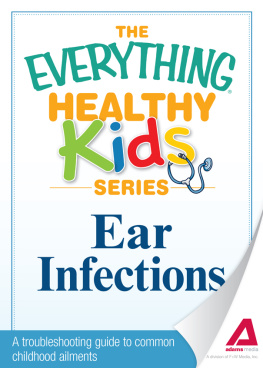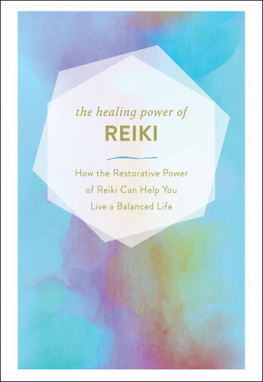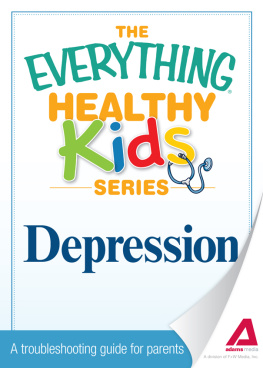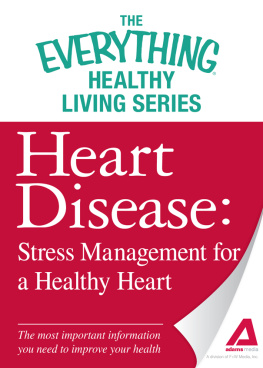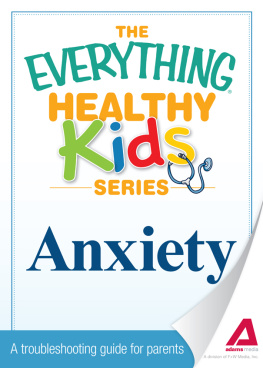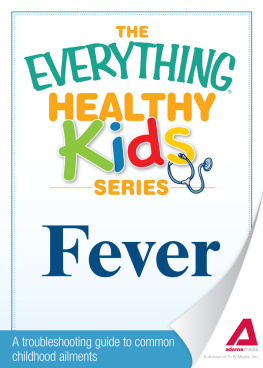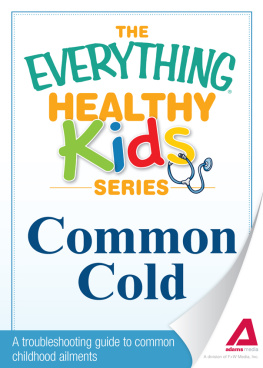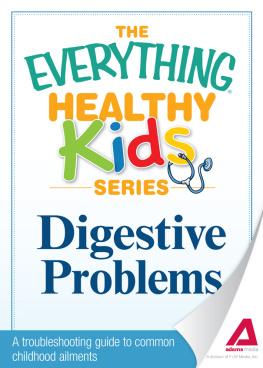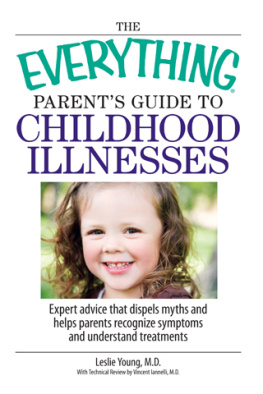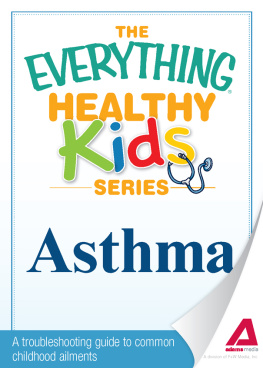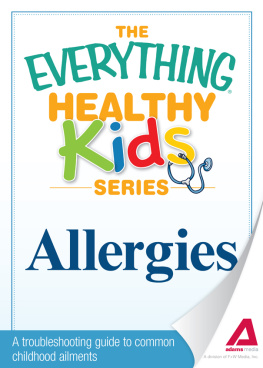The Everything Healthy Kids Series
Ear Infections
A troubleshooting guide to common childhood ailments
Adams Media, a division of F+W Media, Inc.
Avon, Massachusetts
Contents
Introduction
For more than 10 years, millions of readers have trusted the bestselling Everything series for expert advice and important information on parenting and health topics ranging from pregnancy and postpartum care to asthma, dyslexia, and juvenile diabetes. Packed with the most recent, up-to-date data, Everything guides help you get the right diagnosis, choose the best doctor, and find the treatment options that work for your child.
The Everything Healthy Kids Series books are concise guides, focusing on only the essential information you need. Whether youre looking for information on how to treat ailments in children from infants to teenagers, advice on raising happy, well-adjusted kids, or suggestions for how to get your child to eat the right foods, theres an Everything Healthy Kids Book for you.
Childhood Illnesses
Few occasions provoke more anxiety in parents than when a child is ill, and it is the duty of the pediatrician to calm those parental fears in times of distress. The goal of the Everything Healthy Kids Series is not to discredit the ancient wisdom of parenthood. The innate instinct of parents often proves uncanny. Indeed, much of the knowledge that has been passed down through the generations has proved to be both practical and life saving. Everything Healthy Kids books are designed to supplement experience and instinct to empower parents with the latest, most accurate medical information. This allows you to make the best decision for your children when they are not feeling well.
While instinct and experience are often valuable, there are also numerous myths associated with childrens health. Though the origin of most of these misconceptions is obscure and lacking in supporting evidence, they tend to be tenaciously held by many parents. These guides will shed light on these areas of misunderstandings.
This book is not intended to serve as a comprehensive reference book concerning the care of your child. Rather, it is meant to complement medical source books such as those. A typical parent with children is likely to be too tired to read another comprehensive manual on how to raise children. Most parents are lucky to garner enough energy to make it through the day without collapsing. This is a book that you can read while your children are taking their afternoon naps. Not only does it provide an interesting read, it also educates you in a quick and easy format on how to better care for your loved ones.
Because this book is not written for medical professionals, no prior medical knowledge is required to read and understand the content. In fact, one of the aims of this book is to translate inaccessible information and make it available to every parent.
Lastly, this book was purposely designed to have a light tone and to be easy to read. Dealing with a sick child is stressful enough without having to wade through extensive medical jargon for a clear answer. This is definitely not a cut-and-dried medical textbook. At all times, the information is relevant to the reader and readily applicable to real-life situations.
The majority of children will get a few ear infections during childhood. Although most ear infections resolve uneventfully, there are some potentially serious consequences that might complicate an ear infection. In addition, the management of ear infections is not always as straightforward as you might expect. Controversies, even within the professional medical community, can make it tricky for a parent trying to do the right thing for a child. This book will help guide you in the right direction for your childs recovery.
If youd like to learn more about childhood illnesses, check out The Everything Parents Guide to Childhood Illnesses , available in print (978-1-59869-239-6) and eBook (978-1-60550-275-5) formats.
Introducing the Ear
Most people are very familiar with their external ears because they are visible and easily accessible. However, the internal structures of ears and the associated hearing apparatus are much more obscure. The external ear only acts as a physical siphon for sounds. It funnels the sound waves and allows the vibration to be passed into the eardrum, where its vibration is subsequently transformed into nerve signals that can be interpreted by the brain. What makes hearing possible is this intricate system of tubes and ducts, some of which are hollow and some that are filled with fluid. The presence of infection disrupts this delicate mechanism. Ultimately, what pediatricians and parents are most concerned about is preserving normal functionality of hearing.
Ear Anatomy
The anatomy of the ear is divided into three major sections. The external ear is the part of the ear that you can see, extending all the way to the eardrum. The middle ear resides between the eardrum and the inner ear, where the nerves responsible for hearing are located. The middle ear is mostly filled with air, whereas the inner ear is mostly filled with fluid.
The inner structure of the ear is truly a work of wonder. Along with the small tubes that are designed to transmit sound waves, there is a complex drainage system network that allows certain internal structures of the ear to be filled with air and at a pressure equal to the outside environment. Without such a system, the hearing apparatus could not function properly.
In order to maintain this equal pressure, the internal air pocket is connected to the throat via a small duct. This duct is called the Eustachian tube.
Essential
Given that the external ear and the middle ear are separated by a physical barrier (the eardrum), it is virtually impossible to get a middle ear infection from swimming. Swimmers can get swimmers ear, which is an infection of the external ear. This has nothing to do with the typical ear infection, which is an infection of the middle ear.
The Eustachian tube is very small, and it can open and close its connection to the throat at will. Most of the time, the duct is sealed off to prevent food and mucus from entering the air pocket inside the ear. It opens briefly when you open your jaw, swallow, or yawn.
Individual Differences
Just as all people have unique facial features, the internal structure of the ear is also quite varied. The shape of the Eustachian tube that equalizes the pressure inside the ear is different in everyone. Some people have long and narrow tubes, while others have thick and short ones. Depending on the configuration of the tube, some tubes are more likely to stay open than others. The long and narrow ones tend to get clogged with mucus more easily.
Fact
During air travel, the cabin pressure of the airplane is somewhat lower than the atmospheric pressure at sea level. Consequently, the Eustachian tube must open briefly to balance the pressure difference inside the middle ear and the cabin. It is a good idea to give your infant something to drink during these times because she cannot voluntarily yawn or swallow to open up her Eustachian tube.
If the tube becomes obstructed, fluid tends to accumulate inside the middle ear, an area normally filled with air. Once this fluid settles into the middle ear, the risk of infection goes way up. The fact that some peoples Eustachian tubes are more easily blocked than others is the reason why some children tend to suffer from more frequent ear infections. In addition, children tend to have smaller tubes, a configuration that makes them more likely to get clogged with mucus when they have a cold. That is the reason why children get ear infections more often than adults.

